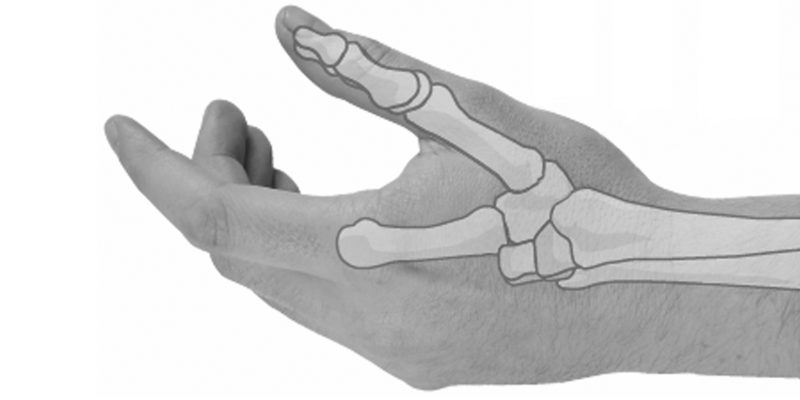
Hand therapy
Osteoarthritis of the carpometacarpal thumb joint
This has been written to provide you with information about your thumb arthritis and give you a better understanding of your thumb joint, why you experience pain, and how you can manage your symptoms
Anatomy of the carpometacarpal thumb joint
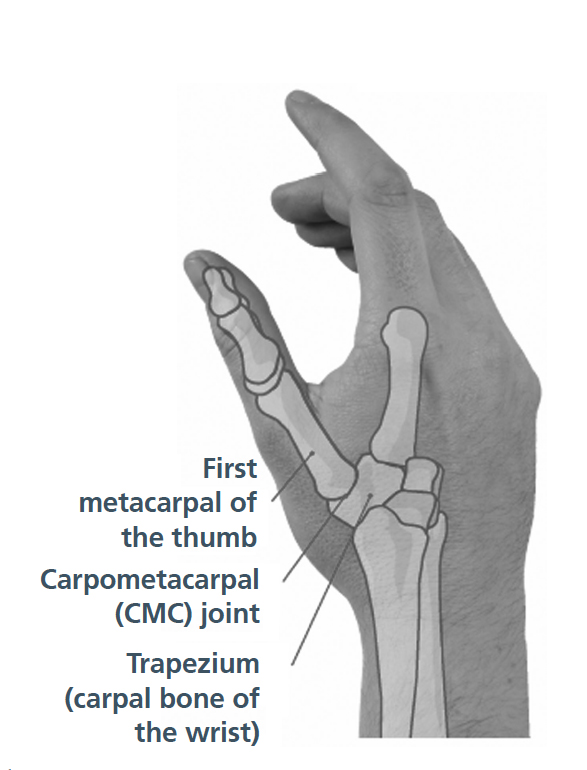
The thumb carpometacarpal (CMC) joint is where the metacarpal bone of the thumb attaches to the trapezium (carpal) bone of the wrist (see diagram right). It is sometimes called the ‘basal’ joint.
What is osteoarthritis (OA)?
Osteoarthritis (OA) is the most common form of arthritis and affects mainly the joint’s cartilage and surrounding bone tissue. There are many factors that can increase the risk of the developing OA; for example it is more common in females over the age of forty, and is more likely to develop in a joint that has had a previous injury or operation.
A joint is where two bones meet to allow movement. Muscles pull on tendons, which are attached to the bone to produce movement. The ends of the bones are covered in a smooth tissue called cartilage that cushions the joint. There is a space between the two ends of bone making up the joint.
The joint is held together within a joint capsule, which contains a thick fluid (synovial fluid) providing lubrication to allow smooth movement. Surrounding ligaments and muscles also maintain the stability of the joint.
When OA develops in a joint, the cartilage gradually roughens and becomes thin, and the bone underneath thickens. The bones at the edge of the joint grow outwards in bony ‘spurs’ (see diagrams below) and excess synovial fluid can be produced, causing the joint to swell.
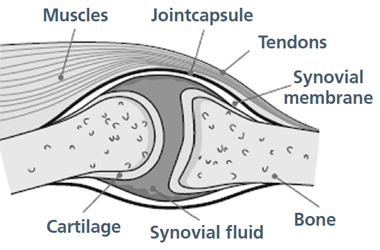

In severe OA, the cartilage can become so thin that it no longer covers the joint surfaces, and damage is caused to the bone ends by them grinding against each other during movement.
This can mean that you avoid using these joints, subsequently causing the surrounding muscles to weaken. This can, over time, change the shape of the joint creating a deformity, as the joint is no longer held in its natural position.
Common symptoms of CMC OA
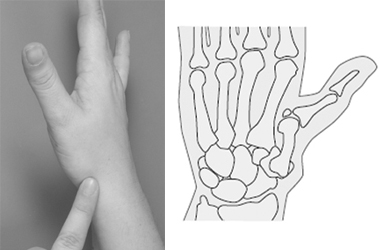
Pain:
Usually felt as a sharp or aching pain at the base of the thumb. The pain is usually worse during movement and relieved by restReduced grip strength:
It may be difficult to grip or pick up objectsStiffness:
Following periods of rest (for example; in mornings)Swelling: Around the base of the thumb
Muscle Weakness and Instability
Deformity: In the later stages of the condition the thumb joint may collapse inwards into a subluxed position (see diagram)
The exercises, joint protection techniques and the use of assistive devices and splints (as described in this booklet) can help to relieve these symptoms and slow the progression of this condition.
Exercises and instructions
Aim to complete the following exercises daily.
They will help to reduce joint stiffness and maintain the range of movement of your thumb.
Exercise within a comfortable and pain free range with your elbow resting on a table or chair arm. If you find the exercises difficult or uncomfortable check that you are doing them correctly and reduce the number of repetitions.
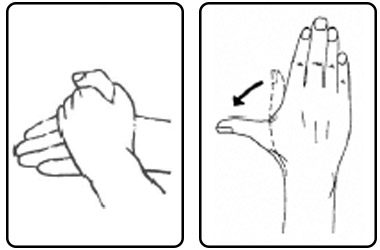
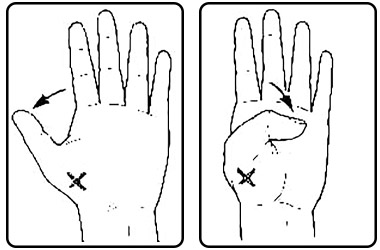
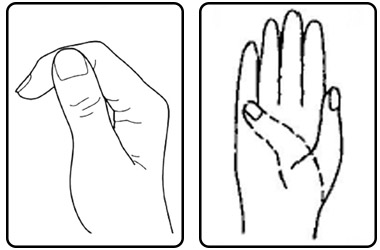
- Place hand and forearm palm up on a table. Using the other hand, stretch the affected thumb out to the side, away from the palm, pushing from the base.
Hold for 10 seconds and repeat three times.
Do not pull from thumb tip. - Place hand palm down on a table. Slide the thumb out to the side along the table as far away from the index finger as comfortable and hold for 10 seconds.
Repeat three times.
Keep the end and middle joints of the thumb bent throughout the exercise. Extend the joint at the base of your thumb out to the side, hold, then return back to the starting position. - Place the thumb on the side of the middle of your first finger. Roll the thumb across the finger as if ‘squashing a fly’.
Touch the tip of your thumb to the base of your little finger and hold for 10 seconds.
Repeat three times. - Place hand palm down on table and move your first (index) finger out to the side towards your thumb. Then move your thumb out towards your first finger. This strengthens a muscle which is attached to the base of your thumb and helps to stabalise your joint.
Repeat three times.
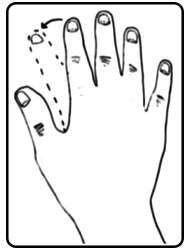
Joint protection
Most people find their own ways of doing activities that are less painful. It is important that you are aware of the activities that cause your thumb joint to be painful so that you know when to wear your splints and consider other ways to perform these activities that place less strain on the painful joints.
Each time you experience thumb pain when doing an activity, stop and consider whether the way you are doing it is causing stress on the joint.

For example:
- When doing activities that involve a pinch grip (for example writing) keep the top joint of the thumb bent and the wrist extended.
- When doing activities that involve turning or twisting avoid fully straightening the top joint of the thumb and the thumb crossing in front of the palm.
The following are joint protection techniques that may help to reduce the pain you experience when doing activities and prevent further damage to the joints:
Take notice of any pain you feel, it can serve as a warning that the way you are performing the activity is causing damage to the joint
Spread the load over several joints (for example; by carrying items on two flat hands rather than gripping with your thumb)
Use larger stronger joints rather than putting the strain through your thumb joints
Use less effort (for example; push or slide heavy items rather than carrying)
Examples of joint protection techniques
Instead of this
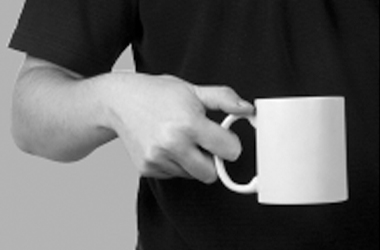
Try this
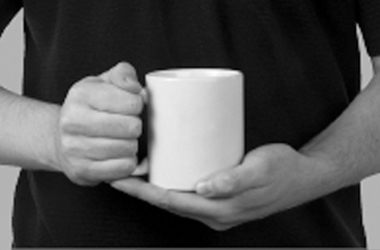
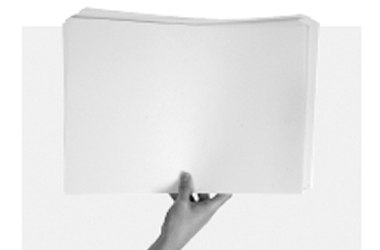
Instead of this (holding a pile of papers with one hand)
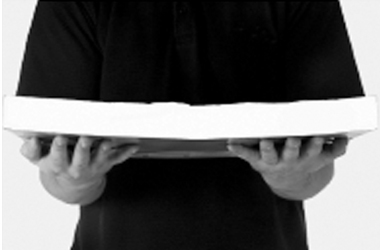
Try this (holding it with two hands)
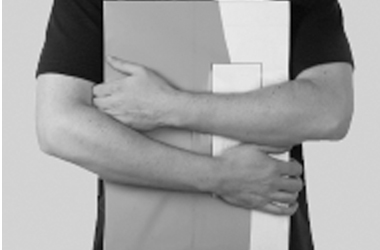
Hug large objects close to your body

‘Shift not lift’ – slide a plastic jug of water to the kettle – only use as much water as you need
Assistive devices
There are a variety of small aids that are available to assist you in maintaining your independence completing daily activities.
For example:
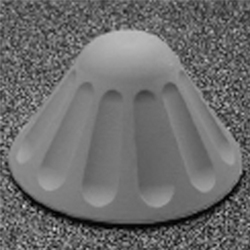
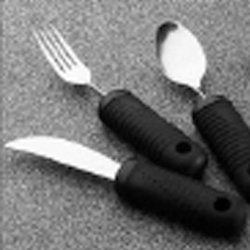
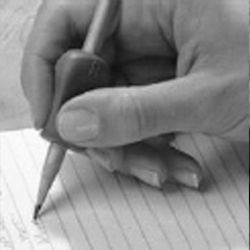
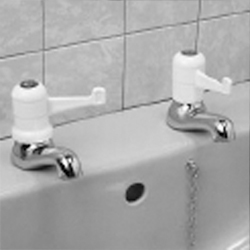
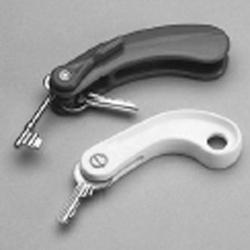
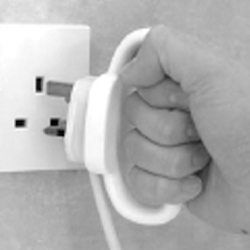
- Jar twisters: Jar twisters to help you open tight jars,
- Wide grip cutlery:
Wide grip cutlery if you find it difficult or painful to hold cutlery. - Pen grips: Pen grips to support your grip or writing.
- Tap turners: Attach onto your taps to make them easier to turn on and off.
- Key turners: Key turners if you have difficulty turning key in door.
- Plug pulls: Assists grip if you have difficulty removing plugs.
The occupational therapist (OT) can discuss specific activities that you are finding difficult or painful and advise you whether any assistive devices are available to help.
You can find details within the further information section of organisations that can advise you about other equipment available.
Splints to support the thumb CMC joint
The therapist will have provided you with a splint to support your thumb joint during activities that cause you pain. You may also have been provided with a resting splint to wear at night.
Some splints are made from soft material (for example; neoprene), others from a thermoplastic material (that is moulded when heated then sets hard), and some are a combination of the two. Your therapist will have chosen the type of splint to meet your individual needs.
Splints are designed to be worn during activities to help reduce the pain you are experiencing and support the joint to help prevent further damage.
You can also wear your splint at night time if you have any pain or during times of a flare-up.
You should wear the splint for activities you find painful but complete light functional activities without the splint to maintain your joint range of movement and muscle strength.
Important
It is important that you complete the exercises and apply the joint protection techniques outlined previously, as well as wearing the splint.
You have been provided with the following splint(s):
………………………………………………………………………………………………..
………………………………………………………………………………………………..
………………………………………………………………………………………………..
………………………………………………………………………………………………..
………………………………………………………………………………………………..
Important information about your splint
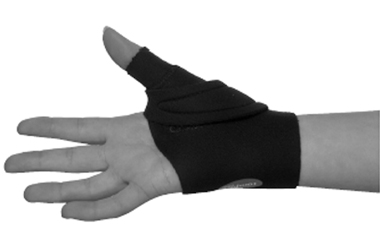
- You should wear the splint at the times indicated by your therapist.
- Do not alter the splint in any way.
- Do not leave the splint where it will get too hot as the splint material or thermoplastic insert may melt (for example; sun, radiator, hot water).
- The splint and straps may be washed in lukewarm soapy water, rinse well and allow to dry naturally. Splints made of neoprene will have washing instructions on the inside label. If it has a plastic insert this should be removed prior to washing the splint and replaced once the splint is dry.
- If you experience any redness, swelling, numbness, discomfort or increased pain stop wearing the splint and contact the department (details can be found below the follow-up information). If this occurs out of office hours and you are concerned that it is an urgent problem you should contact your GP or attend your local accident and emergency department.
- If you want to wear the splint when driving this must be with prior agreement of your insurance company or insurance may be invalid.
- You should not wear the splint when operating machinery unless it has been made for this purpose.
Pain relief
Some people find that paracetamol, anti-inflammatory medications (such as aspirin and ibuprofen) or anti-inflammatory creams can help to reduce the pain experienced.
This should always be discussed with your GP or consultant as they will be able to recommend what type of pain relief and what dose is appropriate for you, depending upon any other medical conditions you have.
Where symptoms are severe cortisone injections may provide temporary relief. Your consultant will decide whether this is indicated.
Surgery
If your symptoms cannot be adequately managed with the methods described within this information, you may want to discuss the possibility of surgery with your consultant. There are a variety of operations that can relieve the symptoms but surgery should be avoided where the symptoms can be managed with other methods.
Common surgical procedures include include removal of arthritic bone, replacement of the joint (arthoplasty), or fusion of the bone.
Your consultant may have arranged to see you again following a period of splinting, or if you have been discharged from their care but feel that you may require surgical intervention you should request a referral by your GP.
Follow up and future care
- You may be asked to attend a follow-up appointment or alternatively you may be contacted by telephone or by letter within the next few weeks to check how you are managing with the splint(s) provided and whether any further therapy intervention is needed.
- If in the future there are any problems with your splint (for example; if it is lost or damaged, needs replacement straps etc) please contact the appropriate department as detailed below.
| Therapist: |
| Contact telephone: |
Further information
Organisations providing information and support for people who have arthritis:
Arthritis Research
Charitable organisation promoting medical research into the cause, treatment and cure of arthritic conditions. Provide information to medical and healthcare professionals, and people affected by arthritis.
Copman House, St Mary’s Court,
St Mary’s Gate, Chesterfield,
Derbyshire, S41 7TD
Telephone: 0300 790 0400
Arthritis Care
User led organisation supporting people who have arthritis. Provide information and support to empower individuals to take control of their arthritis.
Floor 4, Linen Court,
10 East Road, London, N1 6AD
Telephone: 0808 800 4050
Visit the arthritis care website
Disabled Living Foundation
The DLF is a charity providing free advice and training on independent living.
4th Floor, Jessica House, Red Lion Square,
191 Wandsworth High Street, London SW18 4 LS
Telephone: 0207 289 6111
Helpline: 0300 999 0004
Visit the DLF website
Independent Living Centre
The ILC gives free and impartial advice on products and information. It is a resource centre giving open access to assist people with difficulties in everyday activities.
45 – 47 Corporation Road,
Middlesbrough, TS1 1LT
Telephone: 01642 250749
Visit the ILC website
Notes
……………………………………………………………………………………………
……………………………………………………………………………………………
……………………………………………………………………………………………
……………………………………………………………………………………………
……………………………………………………………………………………………
……………………………………………………………………………………………
……………………………………………………………………………………………
……………………………………………………………………………………………
……………………………………………………………………………………………
……………………………………………………………………………………………
……………………………………………………………………………………………
……………………………………………………………………………………………
……………………………………………………………………………………………
……………………………………………………………………………………………
……………………………………………………………………………………………
……………………………………………………………………………………………
……………………………………………………………………………………………
Patient experience
South Tees Hospitals NHS Foundation Trust would like your feedback. If you wish to share your experience about your care and treatment or on behalf of a patient, please contact The Patient Experience Department who will advise you on how best to do this.
This service is based at The James Cook University Hospital but also covers the Friarage Hospital in Northallerton, our community hospitals and community health services.
To ensure we meet your communication needs please inform the Patient Experience Department of any special requirements, for example; braille or large print.
T: 01642 835964
E: [email protected]